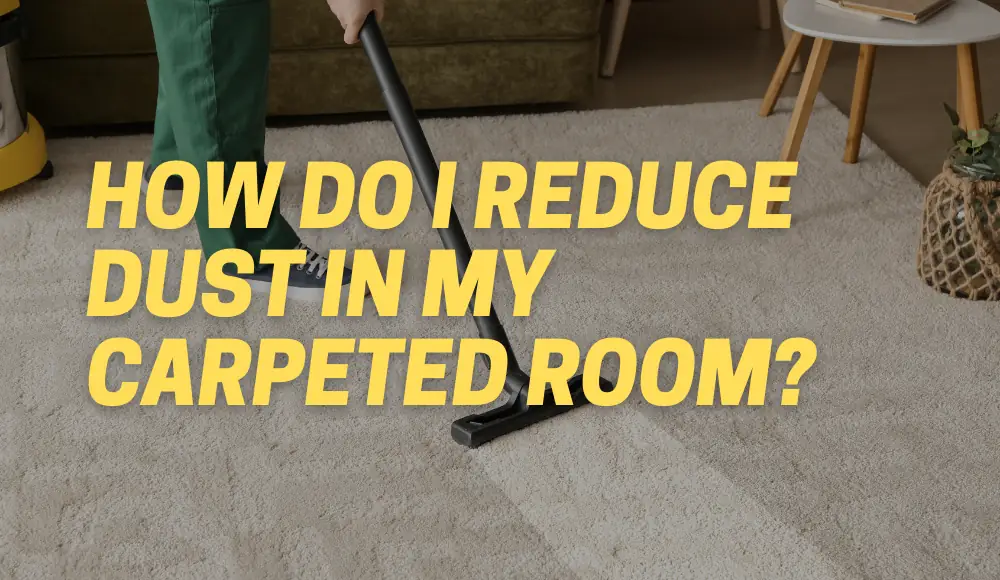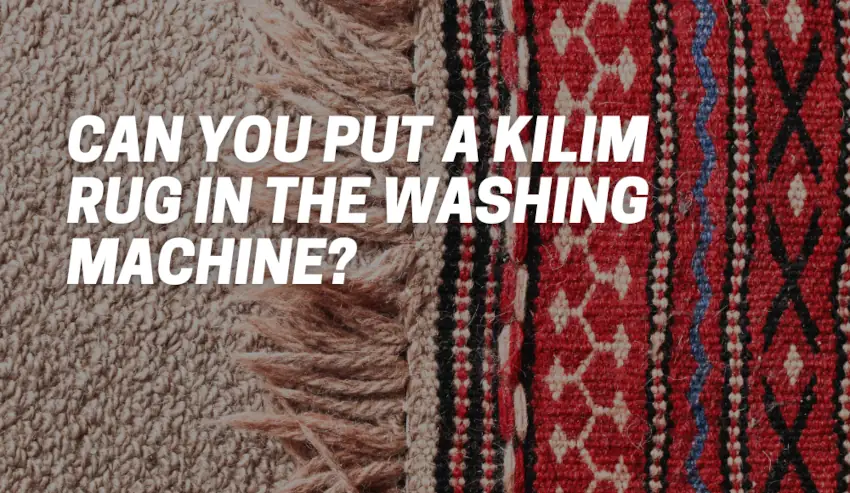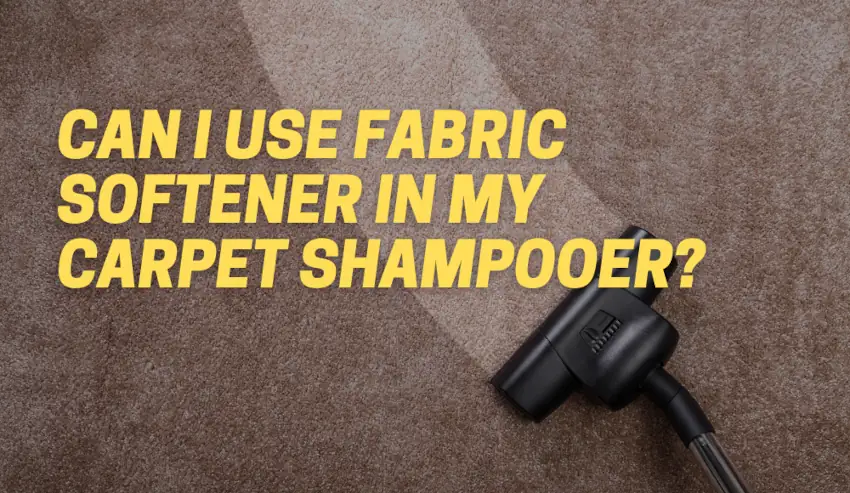Last updated on November 2nd, 2023 at 12:51 am
If you have a carpeted room, you might be familiar with the never-ending battle against dust. It seems like no matter how often you clean, the dust just keeps coming back.
But fear not! In this article, we’ll delve into the reasons why carpeted rooms tend to accumulate more dust, and most importantly, we’ll equip you with practical tips on how to keep your carpeted room cleaner and dust-free.
Do Carpeted Rooms Have More Dust?
Indeed, carpeted rooms do tend to harbor more dust compared to rooms with hard flooring.
This is because carpets have a unique ability to trap dust particles effectively. When you walk around or even just move, you unknowingly stir up dust from the carpet fibers, making it airborne.
As a result, the dust particles settle back down onto the carpet and other surfaces in the room, perpetuating the cycle of dust accumulation.
Why Is There So Much Dust in My Carpets?
Several factors contribute to the amount of dust in your carpets.
- Apart from the dust-trapping property of carpets, outdoor pollutants such as pollen and dirt can find their way into your home, settling onto the carpeted surfaces.
- Additionally, pet dander, dead skin cells, and tiny fabric fibers from clothing also contribute to the dust build-up.
- Moreover, if your home has poor ventilation, it can lead to higher humidity levels.
- High humidity creates an ideal environment for dust mites to thrive, and these microscopic creatures can significantly contribute to the dust levels in your carpeted room.
How Do I Make My Room Less Dusty with Carpet?
Reducing dust in your carpeted room requires a combination of preventive measures and regular cleaning.
Here are some effective tips to help you combat the dust:
1. Vacuum Regularly and Thoroughly
Invest in a good quality vacuum cleaner with a HEPA filter, specifically designed to trap fine dust particles. Regular vacuuming, at least twice a week, can significantly reduce the amount of dust settling in your carpet.
2. Use Doormats
Place doormats at the entrances to your carpeted room to minimize the amount of dirt and dust that gets tracked in from outside. This simple step can make a noticeable difference in dust reduction.
3. Implement a No-Shoes Policy
Encourage your family members and guests to remove their shoes upon entering the room. Shoes can track in dirt and dust from outdoors, which contributes to the dust accumulation in your carpets.
4. Opt for Low Pile Carpets
Consider choosing low-pile or short fiber carpets, as they tend to trap less dust compared to high-pile carpets.
5. Beat Your Rugs and Carpets
Take your smaller rugs and carpets outside and give them a good beating to dislodge trapped dust and dirt. This old-fashioned method is surprisingly effective.
How Do I Keep My Carpet Dust-Free?
In addition to the preventive measures mentioned above, here are some additional tips to help you maintain a dust-free carpeted room:
1. Regularly Change Air Filters
Keep the air in your room clean and dust-free by regularly changing the air filters in your HVAC system. Clean air filters will trap airborne dust particles, preventing them from settling on your carpets.
2. Dust and Clean Surfaces
Regularly dust and clean the surfaces in your carpeted room. Dusting furniture, shelves, and other surfaces will prevent the dust from becoming airborne and settling back onto your carpets.
3. Use Air Purifiers
Consider using air purifiers equipped with HEPA filters to further improve the air quality in your room. Air purifiers can help capture and remove dust particles, reducing dust accumulation on your carpets.
4. Keep Windows Closed on Windy Days
On windy days, keep your windows closed to prevent outdoor dust and pollutants from entering your home and settling on your carpets.
How to Get Dust Out of Carpet Edges
Dust often accumulates in hard-to-reach places, including the edges of your carpets. Here’s a simple technique to get rid of dust from carpet edges:
- Step 1: Take a soft-bristled brush or an old toothbrush and gently sweep along the edges of the carpet to dislodge the dust.
- Step 2: Use a vacuum cleaner with a crevice tool attachment to suck up the loosened dust and debris.
- Step 3: Repeat this process regularly to prevent dust build-up along the carpet edges.
How to Clean Dark Dust Edges on the Carpet
—
How to Remove Dust from Carpet Without Vacuum
If you find yourself without a vacuum cleaner, don’t worry! There are alternative methods to remove dust from your carpets:
- Lint Roller: Use a lint roller to pick up dust and lint from the surface of your carpets. Roll it back and forth to collect as much dust as possible.
- Damp Cloth or Sponge: Dampen a cloth or sponge slightly and gently wipe the carpet surface. The dampness will help pick up and trap dust particles.
- Carpet Sweeper: Invest in a carpet sweeper, which is a manual tool designed to sweep up dust and debris from carpets. It’s an eco-friendly and effective option.
Carpet sweeper
Reducing dust in your carpeted room is not just about cleanliness and aesthetics; it also has a significant impact on your indoor air quality and overall health.
Dust can contain various allergens and pollutants that, when inhaled, may trigger respiratory issues, allergies, and other health problems.
In this extended guide, we will delve deeper into the topic of reducing dust in your carpeted room and explore additional tips and techniques to ensure a healthier and more comfortable living environment.
How To Reduce Dust In Carpeted Room: User Advice
| Main Points to Reduce Dust in Carpeted Room |
|---|
| 1. Remove the carpet: Consider removing the carpet to eliminate a major source of dust and dirt accumulation. |
| 2. Vacuum regularly: Vacuum the carpet at least once a week, or more frequently if you have pets or children. |
| 3. Use a good vacuum cleaner: Invest in a vacuum cleaner with a HEPA filter to trap dust particles effectively. |
| 4. Vacuum in slow, overlapping strokes: Thoroughly vacuum the carpet using slow and overlapping strokes to ensure all dust is removed. |
| 5. Vacuum under furniture and appliances: Don’t forget to vacuum under furniture and appliances where dust can accumulate. |
| 6. Use a damp mop or cloth for hard floors: Clean hard floors with a damp mop or cloth to remove settled dust. |
| 7. Keep doors and windows closed in dusty conditions: Prevent dust from entering the room by keeping doors and windows closed. |
| 8. Use air purifiers: Consider using air purifiers to remove dust particles from the air and improve indoor air quality. |
| 9. Get rid of clutter: Declutter your home to prevent dust from trapping in unnecessary items. |
| 10. Clean carpets regularly: Regularly vacuum carpets or have them professionally cleaned to maintain cleanliness. |
| 11. Use pet hair remover: Remove pet hair from carpets to reduce dust, especially if you have pets. |
| 12. Consider removing carpet: If you have severe allergies or asthma, consider removing the carpet entirely to improve indoor air quality. |
| 13. Keep your home clean and dust-free: Regularly dust furniture, clean shelves, and vacuum under furniture to minimize dust accumulation. |
| 14. Open windows and doors for ventilation: Ventilate your home regularly to reduce dust levels. |
| 15. Use a dehumidifier: Reduce humidity in your home with a dehumidifier to prevent dust accumulation. |
| 16. Fluff carpet fibers regularly: If you have carpet, fluff the fibers regularly to reduce dust build-up. |
| 17. Use drier sheets or Dyson DC24: Consider using drier sheets or a vacuum like the Dyson DC24 to reduce carpet dust. |
| 18. Vacuum fabric materials: Vacuum carpets and curtains to get rid of dust in rooms with fabric materials. |
| 19. Shake smaller carpets outside: Shake smaller carpets outside to prevent dust and debris from spreading in the air. |
The Dust Dilemma: Understanding Indoor Air Quality
Indoor air quality is a critical factor in maintaining a healthy home. According to the Environmental Protection Agency (EPA), indoor air can be up to five times more polluted than outdoor air. One of the primary contributors to indoor air pollution is dust.
Dust particles, ranging from visible to microscopic, can consist of dirt, pollen, pet dander, mold spores, and even chemicals from household products.
In carpeted rooms, these particles tend to settle into the fibers, making it essential to take proactive measures to control dust accumulation.
Addressing Dust at Its Source
To effectively combat dust in your carpeted room, it’s essential to address the sources of dust within your home. Here are some key steps to consider:
1. Keep Your Home Clean
Maintaining a clean home is the foundation of reducing dust. Regularly dust and clean all surfaces, including furniture, shelves, baseboards, and windowsills. Use a microfiber cloth or a damp cloth to capture dust effectively without spreading it into the air.
2. Wash Beddings and Curtains Frequently
Beddings, curtains, and other fabric materials in your home can harbor dust mites and allergens. Wash them in hot water regularly to keep them free from dust and allergens.
3. Groom Pets Regularly
If you have pets, their fur can contribute to dust accumulation. Groom your pets regularly to reduce shedding, and wash their bedding to minimize dust in their resting areas.
4. Control Humidity Levels
As mentioned earlier, high humidity can foster the growth of dust mites. Use a dehumidifier or air conditioner to keep indoor humidity levels between 30% and 50%.
5. Use Air Purifiers
Air purifiers with HEPA filters can help trap dust particles and allergens, improving your indoor air quality. Place them strategically throughout your home, paying special attention to the carpeted room.
6. Regularly Change HVAC Filters
Change the filters in your heating, ventilation, and air conditioning (HVAC) system according to the manufacturer’s recommendations. This will help prevent dust particles from circulating through your home.
Unveiling the Secret of HEPA Filters
High-Efficiency Particulate Air (HEPA) filters are instrumental in improving indoor air quality. These filters can trap up to 99.97% of airborne particles as small as 0.3 microns.

Investing in a vacuum cleaner and air purifier with HEPA filters can significantly reduce dust in your carpeted room.
When selecting a vacuum cleaner, ensure that it has a sealed system, which prevents dust from escaping through gaps in the machine.
The Power of Regular Vacuuming
Vacuuming is your primary defense against dust in a carpeted room. As mentioned before, using a vacuum cleaner with a HEPA filter is essential for effectively trapping and containing dust particles. But the frequency and technique of vacuuming are equally critical.
Vacuuming Frequency
The frequency of vacuuming will depend on factors such as foot traffic, pets, and indoor air quality. For high-traffic areas, vacuum at least twice a week, while low-traffic areas may only require vacuuming once a week.
Slow and Steady Wins the Race
When vacuuming, take your time and move the vacuum cleaner slowly over the carpet. This allows the vacuum to effectively lift dirt and dust from deep within the carpet fibers. Going too quickly may not give the vacuum enough time to capture all the particles.
Don’t Forget to Vacuum Upholstered Furniture
Upholstered furniture, such as sofas and chairs, can also harbor dust and allergens. Be sure to vacuum them regularly using an upholstery attachment to keep them clean and free of dust.
Deep Cleaning Carpets: The Steam Cleaning Advantage
Regular vacuuming is essential, but deep cleaning your carpets periodically is equally important. Steam cleaning, also known as hot water extraction, is one of the most effective methods to remove deep-seated dirt and allergens from your carpets.
Steam cleaning involves using hot water and a cleaning solution to penetrate the carpet fibers, loosening dirt and dust.
The machine then extracts the water along with the dirt, leaving your carpets refreshed and clean. This method is particularly useful for homes with allergies or asthma sufferers, as it helps reduce allergens significantly.
Embracing Natural Solutions: Baking Soda and Vinegar
If you prefer natural cleaning solutions, baking soda and vinegar can be your allies in the fight against dust in your carpeted room.
Baking Soda
Sprinkling baking soda over your carpet before vacuuming can help neutralize odors and absorb moisture, making it more challenging for dust mites to survive. Let the baking soda sit for about 15-20 minutes before vacuuming it up.
Vinegar
Mix equal parts of white vinegar and water in a spray bottle. Lightly spray this solution over your carpet, then use a damp cloth to blot and clean the area. The vinegar’s acidity can help break down and dissolve dust and dirt, leaving your carpet refreshed.
The Perimeter Patrol: Dusting and Cleaning Along Carpet Edges
Dust often accumulates along the edges of your carpets, where the vacuum cleaner may not reach as effectively. Here’s a step-by-step guide to addressing this pesky problem:
- Step 1: Grab your trusty soft-bristled brush or an old toothbrush. Gently sweep along the edges of the carpet to dislodge dust and debris.
- Step 2: Use your vacuum cleaner’s crevice tool attachment to suck up the loosened dust and dirt along the edges.
- Step 3: For a final touch, use a microfiber cloth dampened with water to wipe along the edges, ensuring a thorough clean.
The Art of Beating Dust Out of Rugs and Carpets
Remember the good old days when people used to take their rugs and carpets outside for a good beating? Well, this time-tested method is still highly effective.
Take your smaller rugs and carpets outside and give them a good beating with a rug beater or a sturdy stick. The physical impact will dislodge trapped dust and dirt, leaving your rugs refreshed and rejuvenated. Just be mindful of your surroundings and make sure to do the beating in an appropriate area.
FAQs
Is there a simple trick to eliminate dust in my house?
Yes, maintaining a clean and clutter-free living space is one of the simplest and most effective ways to reduce dust in your home. Regularly dusting, vacuuming, and keeping windows closed on windy days can go a long way in minimizing dust levels.
—
Can indoor plants help reduce dust in my carpeted room?
Yes, certain indoor plants can help improve indoor air quality by absorbing dust and pollutants. Some excellent choices include spider plants, peace lilies, and snake plants. Just be mindful of any allergies you or your family members may have to certain plants.
Can professional carpet cleaning help reduce dust in my carpeted room?
Absolutely! Professional carpet cleaning, especially using methods like steam cleaning, can significantly reduce dust and allergens in your carpets. It’s recommended to have your carpets professionally cleaned at least once a year or more frequently in high-traffic areas.
What other measures can I take to improve indoor air quality besides reducing dust?
Improving indoor air quality goes beyond dust reduction. Consider proper ventilation, using air purifiers, and eliminating or reducing the use of chemical-based household products. Additionally, regular HVAC maintenance, such as changing filters, is essential for ensuring cleaner indoor air.
Are air purifiers with ionizers effective in reducing dust?
Air purifiers with ionizers can be effective in reducing dust by charging particles, causing them to stick to surfaces or other particles. However, be cautious if you have respiratory issues, as ionizers may produce ozone, which can be harmful in high concentrations. It’s best to opt for air purifiers with HEPA filters for dust reduction.
Conclusion
The battle against dust in your carpeted room may seem like a constant struggle, but with the right approach, you can significantly reduce dust levels and improve your indoor air quality.
By addressing dust at its source, using HEPA filters, implementing regular and thorough vacuuming, and embracing natural cleaning solutions, you can create a healthier and more comfortable living environment.
Remember that reducing dust is an ongoing process that requires consistent effort, but the rewards in terms of improved air quality and overall well-being are well worth it. So, put these tips into action, and breathe easier in your clean and dust-free carpeted room!




